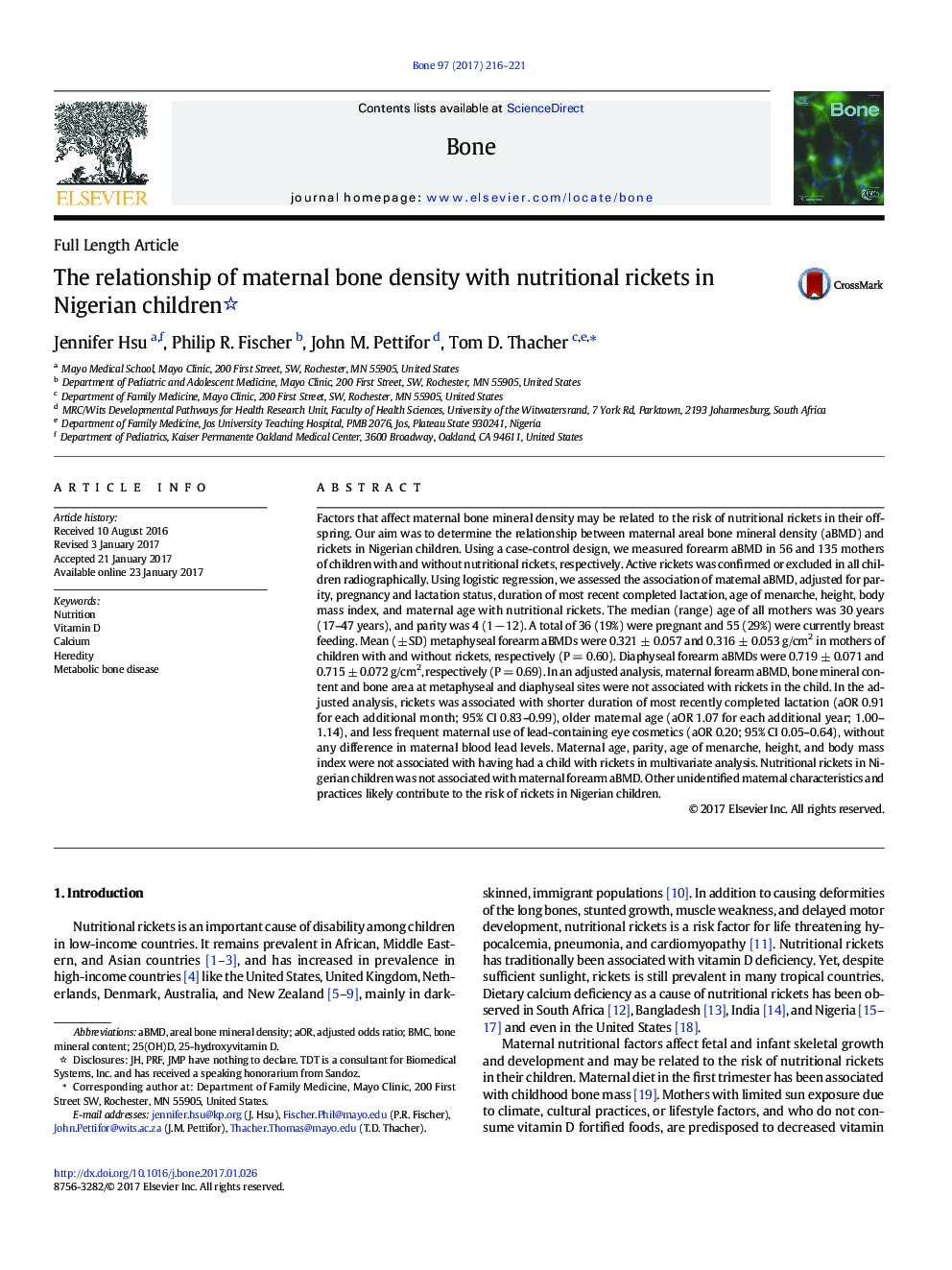| کد مقاله | کد نشریه | سال انتشار | مقاله انگلیسی | نسخه تمام متن |
|---|---|---|---|---|
| 5585425 | 1568122 | 2017 | 6 صفحه PDF | دانلود رایگان |
عنوان انگلیسی مقاله ISI
The relationship of maternal bone density with nutritional rickets in Nigerian children
ترجمه فارسی عنوان
رابطه تراکم استخوان مادر با ریتم های تغذیه ای در کودکان نیجریه
دانلود مقاله + سفارش ترجمه
دانلود مقاله ISI انگلیسی
رایگان برای ایرانیان
کلمات کلیدی
AORBMCaBMD25(OH)D - 25 (OH) D25-hydroxyvitamin D - 25 هیدروکسی ویتامین DMetabolic bone disease - بیماری استخوانی متابولیکAreal bone mineral density - تراکم معدنی استخوان منطقهNutrition - تغذیهBone mineral content - محتوای مواد معدنی استخوانadjusted odds ratio - نسبت شانس تنظیم شده استHeredity - وراثتVitamin D - ویتامین دیCalcium - کلسیم
موضوعات مرتبط
علوم زیستی و بیوفناوری
بیوشیمی، ژنتیک و زیست شناسی مولکولی
زیست شناسی تکاملی
چکیده انگلیسی
Factors that affect maternal bone mineral density may be related to the risk of nutritional rickets in their offspring. Our aim was to determine the relationship between maternal areal bone mineral density (aBMD) and rickets in Nigerian children. Using a case-control design, we measured forearm aBMD in 56 and 135 mothers of children with and without nutritional rickets, respectively. Active rickets was confirmed or excluded in all children radiographically. Using logistic regression, we assessed the association of maternal aBMD, adjusted for parity, pregnancy and lactation status, duration of most recent completed lactation, age of menarche, height, body mass index, and maternal age with nutritional rickets. The median (range) age of all mothers was 30 years (17-47 years), and parity was 4 (1 â 12). A total of 36 (19%) were pregnant and 55 (29%) were currently breast feeding. Mean (± SD) metaphyseal forearm aBMDs were 0.321 ± 0.057 and 0.316 ± 0.053 g/cm2 in mothers of children with and without rickets, respectively (P = 0.60). Diaphyseal forearm aBMDs were 0.719 ± 0.071 and 0.715 ± 0.072 g/cm2, respectively (P = 0.69). In an adjusted analysis, maternal forearm aBMD, bone mineral content and bone area at metaphyseal and diaphyseal sites were not associated with rickets in the child. In the adjusted analysis, rickets was associated with shorter duration of most recently completed lactation (aOR 0.91 for each additional month; 95% CI 0.83-0.99), older maternal age (aOR 1.07 for each additional year; 1.00-1.14), and less frequent maternal use of lead-containing eye cosmetics (aOR 0.20; 95% CI 0.05-0.64), without any difference in maternal blood lead levels. Maternal age, parity, age of menarche, height, and body mass index were not associated with having had a child with rickets in multivariate analysis. Nutritional rickets in Nigerian children was not associated with maternal forearm aBMD. Other unidentified maternal characteristics and practices likely contribute to the risk of rickets in Nigerian children.
ناشر
Database: Elsevier - ScienceDirect (ساینس دایرکت)
Journal: Bone - Volume 97, April 2017, Pages 216-221
Journal: Bone - Volume 97, April 2017, Pages 216-221
نویسندگان
Jennifer Hsu, Philip R. Fischer, John M. Pettifor, Tom D. Thacher,
